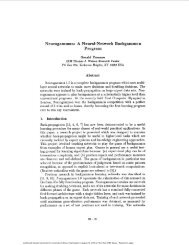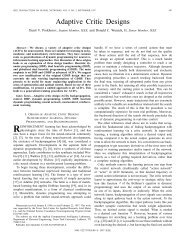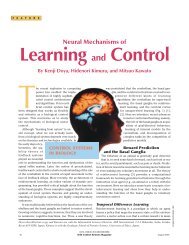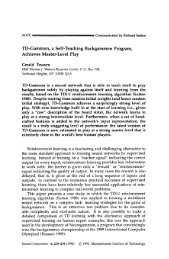1860 IEEE TRANSACTIONS ON NEURAL NETWORKS, VOL. 22, NO. 12, DECEMBER 2011State trajectories10.80.60.40.20−0.2−0.4−0.6−0.8−10 10 20 30 40 50 60 70 80 90 100<strong>Time</strong> stepx 1η 1Per<strong>for</strong>mance index function0.70.650.60.550.50.450.40.350 20 40 60 80 100 120 140 160 180 200Iteration stepFig. 7. State variable trajectory x 1 and desired trajectory η 1 .Fig. 9.Convergence <strong>of</strong> per<strong>for</strong>mance index.State trajectories10.80.60.40.20−0.2−0.4−0.6−0.8−10 10 20 30 40 50 60 70 80 90 100<strong>Time</strong> stepFig. 8. State variable trajectory x 2 and desired trajectory η 2 .x 2η 2Error trajectories0.60.40.20−0.2−0.4−0.6−0.8−1−1.20 10 20 30 40 50 60 70 80 90 100<strong>Time</strong> stepFig. 10. <strong>Tracking</strong> error trajectories e 1 and e 2 .e 1e 2nondecreasing. Furthermore, it converges to the optimal per<strong>for</strong>manceindex function as i →∞.ThecurveinFig.5showsthe properties <strong>of</strong> the per<strong>for</strong>mance index function sequence.According to Theorem 4, we know that (11) is asymptoticallystable. The error trajectories between (76) and Hénon chaoticsignal are presented in Fig. 6, and they converge to zeroasymptotically. It is clear that the new HDP iteration algorithmis very feasible.B. Example 2In this subsection, we consider the following nonlinear timedelay system:whereandx(k + 1) = f (x(k), x(k − 1), x(k − 2))+g(x(k), x(k − 1), x(k − 2))u(k)x(k) = ε 1 (k), −2 ≤ k ≤ 0 (78)f (x(k), x(k − 1), x(k − 2))[ ]0.2x1 (k) exp (x 2 (k)) 2 x 2 (k − 2)=0.3 (x 2 (k)) 2 x 1 (k − 1)g(x(k), x(k − 1), x(k − 2)) =[ ]x2 (k − 2) 0.0 1From (78), we know that g(·) is not always invertible.Here Moore-Penrose pseudoinverse technique is used to obtaing −1 (·).The desired orbit η(k) is generated by the followingexosystem:withA =η(k + 1) = Aη(k) (79)[ ] [ ]cos wT sin wT0, η(0) =− sin wT cos wT1where T = 0.1 s,w = 0.8π.At first, we give the initial states as ε 1 (−2) = ε 1 (−1) =ε 1 (0) = [ 0.5 −0.2 ] T , and the initial control policy as β(k) =−2x(k). We also implement the proposed HDP algorithm atthe time instant k = 3. The maximal iteration step i max is 60.The learning rate is α a = α c = 0.01, and other parameters inBP neural networks are the same as in Example 1. We selectQ = R = I 2 .The trajectories <strong>of</strong> the system states are presented in Figs. 7and 8. In the two figures, the solid lines are the system states,and the dashed lines are the desired trajectories. In addition,we give the curve <strong>of</strong> the per<strong>for</strong>mance index sequence in Fig. 9.It is bounded and convergent. It verifies Theorems 1 and 3 aswell. The tracking errors show in Fig. 10, which converge tozero asymptotically. It is clear that the tracking per<strong>for</strong>mance issatisfactory, and the new iteration algorithm proposed in thispaper is very effective.
ZHANG et al.: OPTIMAL TRACKING CONTROL FOR A CLASS OF NONLINEAR DISCRETE-TIME SYSTEMS WITH TIME DELAYS BASED ON HDP 1861VI. CONCLUSIONIn this paper, we proposed an effective HDP algorithmto solve optimal tracking problem <strong>for</strong> a class <strong>of</strong> nonlineardiscrete-time systems with time delays. First we defined aper<strong>for</strong>mance index <strong>for</strong> time delay systems. Then a novel iterationHDP algorithm has been developed to solve the optimaltracking control problem. Two neural networks have been usedto facilitate the implementation <strong>of</strong> the iteration algorithm.Simulation examples have demonstrated the effectiveness <strong>of</strong>the proposed optimal tracking control algorithm.REFERENCES[1] M. Z. Manu and J. Mohammad, <strong>Time</strong>-Delay Systems Analysis, Optimizationand Applications. New York: North-Holland, 1987.[2] D. H. Chyung, “On the controllability <strong>of</strong> linear systems with delay incontrol,” IEEE Trans. Autom. <strong>Control</strong>, vol. 15, no. 2, pp. 255–257, Apr.1972.[3] D. H. Chyung, “<strong>Control</strong>lability <strong>of</strong> linear systems with multiple delaysin control,” IEEE Trans. Autom. <strong>Control</strong>, vol. 15, no. 6, pp. 694–695,Dec. 1970.[4] H. Y. Shao and Q. L. Han, “New delay-dependent stability criteria<strong>for</strong> neural networks with two additive time-varying delay components,”IEEE Trans. Neural Netw., vol. 22, no. 5, pp. 812–818, May 2011.[5] J. P. Richard, “<strong>Time</strong>-delay systems: An overview <strong>of</strong> some recentadvances and open problems,” Automatica, vol. 39, no. 10, pp. 1667–1694, Oct. 2003.[6] S. C. Tong, Y. M. Li, and H. G. Zhang, “Adaptive neural networkdecentralized backstepping output-feedback control <strong>for</strong> nonlinear largescalesystems with time delays,” IEEE Trans. Neural Netw., vol. 22,no. 7, pp. 1073–1086, Jul. 2011.[7] V. N. Phat and H. Trinh, “Exponential stabilization <strong>of</strong> neural networkswith various activation functions and mixed time-varying delays,” IEEETrans. Neural Netw., vol. 21, no. 7, pp. 1180–1184, Jul. 2010.[8] Y. J. Liu, C. L. P. Chen, G.-X. Wen, and S. C. Tong, “Adaptive neuraloutput feedback tracking control <strong>for</strong> a class <strong>of</strong> uncertain discrete-timenonlinear systems,” IEEE Trans. Neural Netw., vol. 22, no. 7, pp. 1162–1167, Jul. 2011.[9] M. Wang, S. S. Ge, and K. S. Hong, “Approximation-based adaptivetracking control <strong>of</strong> pure-feedback nonlinear systems with multipleunknown time-varying delays,” IEEE Trans. Neural Netw., vol. 21,no. 11, pp. 1804–1816, Nov. 2010.[10] W. S. Chen and L. C. Jiao, “Adaptive tracking <strong>for</strong> periodically timevaryingand nonlinearly parameterized systems using multilayer neuralnetworks,” IEEE Trans. Neural Netw., vol. 21, no. 2, pp. 345–351, Feb.2010.[11] W. Y. Lan and J. Huang, “Neural-network-based approximate outputregulation <strong>of</strong> discrete-time nonlinear systems,” IEEE Trans. NeuralNetw., vol. 18, no. 4, pp. 1196–1208, Jul. 2007.[12] C. M. Zhang, G. Y. Tang, and S. Y. Han, “Approximate design <strong>of</strong>optimal tracking controller <strong>for</strong> systems with delayed state and control,”in Proc. IEEE Int. Conf. <strong>Control</strong> Autom., Christchurch, New Zealand,Dec. 2009, pp. 1168–1172.[13] Y. D. Zhao, G. Y. Tang, and C. Li, “<strong>Optimal</strong> output tracking control<strong>for</strong> nonlinear time-delay systems,” in Proc. 6th World Congr. Intell.<strong>Control</strong> Autom., Dalian, China, Jun. 2006, pp. 757–761.[14] Y. M. Park, M. S. Choi, and K. Y. Lee, “An optimal tracking neurocontroller<strong>for</strong> nonlinear dynamic systems,” IEEE Trans. Neural Netw.,vol. 7, no. 5, pp. 1009–1110, Sep. 1996.[15] J. Fu, H. B. He, and X. M. Zhou, “Adaptive learning and control <strong>for</strong>MIMO system based on adaptive dynamic programming,” IEEE Trans.Neural Netw., vol. 22, no. 7, pp. 1133–1148, Jul. 2011.[16] R. E. Bellman, Dynamic Programming. Princeton, NJ: Princeton Univ.Press, 1957.[17] P. J. Werbos, “A menu <strong>of</strong> designs <strong>for</strong> rein<strong>for</strong>cement learning over time,”in Neural Networks <strong>for</strong> <strong>Control</strong>, W. T. Miller, R. S. Sutton, and P. J.Werbos, Eds. Cambridge, MA: MIT Press, 1991, pp. 67–95.[18] A. Al-Tamimi, F. L. Lewis, and M. Abu-Khalaf, “Model-free Q-learningdesigns <strong>for</strong> linear discrete-time zero-sum games with application toH-infinity control,” Automatica, vol. 43, no. 3, pp. 473–481, Mar. 2007.[19] D. Vrabie, O. Pastravanu, M. Abu-Khalaf, and F. L. Lewis, “Adaptiveoptimal control <strong>for</strong> continuous-time linear systems based on policyiteration,” Automatica, vol. 45, no. 2, pp. 477–484, Feb. 2009.[20] K. G. Vamvoudakis and F. L. Lewis, “Online actor critic algorithm tosolve the continuous-time infinite horizon optimal control problem,”Automatica, vol. 46, no. 5, pp. 878–888, May 2010.[21] W. B. Powell, Approximate Dynamic Programming: Solving the Curses<strong>of</strong> Dimensionality. New York: Wiley, 2009.[22] C. Zheng and S. Jagannathan, “Generalized Hamilton–Jacobi–Bellman<strong>for</strong>mulation-based neural network control <strong>of</strong> affine nonlinear discretetimesystems,” IEEE Trans. Neural Netw., vol. 19, no. 1, pp. 90–106,Jan. 2008.[23] P. He and S. Jagannathan, “Rein<strong>for</strong>cement learning neural-networkbasedcontroller <strong>for</strong> nonlinear discrete-time systems with inputconstraints,” IEEE Trans. Syst., Man, Cybern., Part B: Cybern.,vol. 37, no. 2, pp. 425–436, Apr. 2007.[24] J. J. Murray, C. J. Cox, G. G. Lendaris, and R. Saeks, “Adaptivedynamic programming,” IEEE Trans. Syst., Man, Cybern., Part C:Appl. Rev., vol. 32, no. 2, pp. 140–153, May 2002.[25] B. H. Li and J. Si, “Approximate robust policy iteration using multilayerperceptron neural networks <strong>for</strong> discounted infinite-horizon Markovdecision processes with uncertain correlated transition matrices,” IEEETrans. Neural Netw., vol. 21, no. 8, pp. 1270–1280, Aug. 2010.[26] J. Si and Y. T. Wang, “Online learning control by association andrein<strong>for</strong>cement,” IEEE Trans. Neural Netw., vol. 12, no. 2, pp. 264–276,Mar. 2001.[27] R. Enns and J. Si, “Helicopter trimming and tracking control usingdirect neural dynamic programming,” IEEE Trans. Neural Netw.,vol. 14, no. 4, pp. 929–939, Jul. 2003.[28] F. Y. Wang, N. Jin, D. R. Liu, and Q. L. Wei, “Adaptive dynamicprogramming <strong>for</strong> finite-horizon optimal control <strong>of</strong> discrete-timenonlinear systems with ε-error bound,” IEEE Trans. Neural Netw.,vol. 22, no. 1, pp. 24–36, Jan. 2011.[29] H. G. Zhang, Q. L. Wei, and D. R. Liu, “An iterative adaptivedynamic programming method <strong>for</strong> solving a class <strong>of</strong> nonlinear zero-sumdifferential games,” Automatica, vol. 47, no. 1, pp. 207–214, Jan. 2011.[30] P. J. Werbos, “Approximate dynamic programming <strong>for</strong> real-time controland neural modeling,” in Handbook <strong>of</strong> Intelligent <strong>Control</strong>: Neural,Fuzzy, and Adaptive Approaches, D.A.WhiteandD.A.S<strong>of</strong>ge,Eds.New York: Van Nostrand, 1992, ch. 13.[31] J. Seiffertt, S. Sanyal, and D. C. Wunsch, “Hamilton–Jacobi–Bellmanequations and approximate dynamic programming on time scales,”IEEE Trans. Syst., Man, Cybern., Part B: Cybern., vol. 38, no. 4, pp.918–923, Aug. 2008.[32] Y. Zhao, S. D. Patek, and P. A. Beling, “Decentralized Bayesian searchusing approximate dynamic programming methods,” IEEE Trans. Syst.,Man, Cybern., Part B: Cybern., vol. 38, no. 4, pp. 970–975, Aug. 2008.[33] F. L. Lewis and D. Vrabie, “Rein<strong>for</strong>cement learning and adaptivedynamic programming <strong>for</strong> feedback control,” IEEE Circuits Syst. Mag.,vol. 9, no. 3, pp. 32–50, Sep. 2009.[34] F. Y. Wang, H. G. Zhang, and D. R. Liu, “Adaptive dynamicprogramming: An introduction,” IEEE Comput. Intell. Mag., vol. 4,no. 2, pp. 39–47, May 2009.[35] S. J. Bradtke, B. E. Ydestie, and A. G. Barto, “Adaptive linear quadraticcontrol using policy iteration,” in Proc. Amer. <strong>Control</strong> Conf., vol.3.Baltimore, MD, Jun. 1994, pp. 3475–3479.[36] A. Al-Tamimi, F. L. Lewis, and M. Abu-Khalaf, “<strong>Discrete</strong>-timenonlinear HJB solution using approximate dynamic programming:Convergence pro<strong>of</strong>,” IEEE Trans. Syst., Man, Cybern., Part B: Cybern.,vol. 38, no. 4, pp. 943–949, Aug. 2008.[37] H. G. Zhang, Q. L. Wei, and Y. H. Luo, “A novel infinite-time optimaltracking control scheme <strong>for</strong> a class <strong>of</strong> discrete-time nonlinear systemsvia the greedy HDP iteration algorithm,” IEEE Trans. Syst., Man,Cybern., Part B: Cybern., vol. 38, no. 4, pp. 937–942, Aug. 2008.[38] H. G. Zhang, Y. H. Luo, and D. R. Liu, “Neural-network-based nearoptimalcontrol <strong>for</strong> a class <strong>of</strong> discrete-time affine nonlinear systemswith control constraints,” IEEE Trans. Neural Netw., vol. 20, no. 9, pp.1490–1503, Sep. 2009.[39] A. Isidori, <strong>Nonlinear</strong> <strong>Control</strong> Systems II. New York: Springer-Verlag,2005.[40] S. B. Gershwin and D. H. Jacobson, “A controllability theory <strong>for</strong>nonlinear systems,” IEEE Trans. Autom. <strong>Control</strong>, vol. 16, no. 1, pp.37–46, Feb. 1971.[41] A. Bicchi, A. Marigo, and B. Piccoli, “On the reachability <strong>of</strong> quantizedcontrol systems,” IEEE Trans. Autom. <strong>Control</strong>, vol. 47, no. 4, pp.546–563, Apr. 2002.[42] A. Ben-Israel and T. N. E. Greville, Generalized Inverse: Theory andApplications, 2nd ed. New York: Springer-Verlag, 2002.









